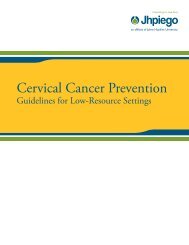Manual for Male Circumcision under Local Anaesthesia
Manual for Male Circumcision under Local Anaesthesia
Manual for Male Circumcision under Local Anaesthesia
Create successful ePaper yourself
Turn your PDF publications into a flip-book with our unique Google optimized e-Paper software.
<strong>Male</strong> circumcision <strong>under</strong> local anaesthesia<br />
Version 3.1 (Dec09)<br />
counselling and testing services are limited. Knowledge of HIV status<br />
is important, so that those infected can seek advice, support and<br />
proper care, and can take measures to avoid passing the infection to<br />
others. Care includes prophylaxis with cotrimoxazole to reduce the<br />
rate of progression to acquired immunodeficiency syndrome (AIDS),<br />
and antiretroviral treatment when clinically indicated. These<br />
treatments are becoming more widely available in developing<br />
countries. Specific in<strong>for</strong>mation and messages can also be given to<br />
people known to be uninfected with HIV to help them remain free of<br />
infection.<br />
Barriers to male sexual and reproductive health services<br />
There are a number of barriers to the development and use of<br />
reproductive health services <strong>for</strong> men, including:<br />
• a lack of in<strong>for</strong>mation on men’s needs and concerns that could be<br />
used to design appropriate programmes and services;<br />
• embarrassment and alienation among men about using health<br />
facilities that are primarily designed to address women’s<br />
reproductive health issues;<br />
• men’s reluctance to seek medical care;<br />
• inadequate training of health workers to address men’s sexual and<br />
reproductive health issues;<br />
• limited availability of contraceptive methods <strong>for</strong> men;<br />
• negative attitudes of policy-makers and service providers towards<br />
men; <strong>for</strong> example, viewing men as irresponsible, or not interested<br />
in playing a positive role in support of women’s reproductive health<br />
needs, or not an appropriate clientele <strong>for</strong> sexual and reproductive<br />
health services;<br />
• unfavourable legal and policy constraints, such as bans on<br />
promotion of condoms;<br />
• logistic constraints such as lack of separate waiting and service<br />
areas <strong>for</strong> men, lack of trained male staff, lack of male-friendly<br />
clinics, and inconvenient clinic hours.<br />
These barriers must be addressed if men are to become more<br />
involved in sexual and reproductive health matters.<br />
MEETING THE SEXUAL AND REPRODUCTIVE HEALTH NEEDS OF MEN<br />
Access to sexual and reproductive health services is a human rights<br />
issue <strong>for</strong> women, men and young people. The lack of services to<br />
address the sexual and reproductive health needs of men contributes<br />
to stress and anxiety among them. 2 Various strategies have been<br />
used to extend sexual and reproductive health services to men, and to<br />
engage men as partners in improving women’s sexual and<br />
reproductive health:<br />
Linking male circumcision and other male SRH services Chapter 2-4
















